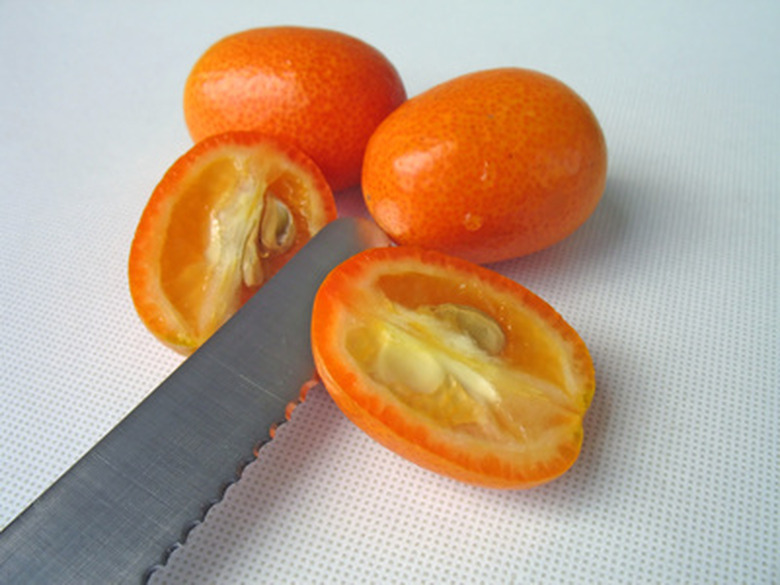What Makes The Leaves Of My Kumquat Tree Fall Off?
Although kumquats are generally regarded as a member of the citrus family, they belong to a different genus, Fortunella. The kumquat includes several similar species, all having small, citrus-like fruit with yellow to orange skin. Plants can reach 9 or 10 feet tall and can tolerate temperatures as low as 10 to 15 degrees F. They prefer hot summers: in areas where the summer mercury climbs to 100 degrees F, kumquats produce large, sweet fruit.
History
Native to China, the kumquat was first mentioned in literature in 1178 A.D., according to Purdue University Center for New Crops. By the early 1700s, kumquats were cultivated in Japan and became common beginning in the mid 1900s in both North America and Europe. Kumquats were sometimes grown in greenhouses as ornamentals. In modern times, kumquats are grown commercially in California, Texas and Florida and in some Central and South American countries.
- Although kumquats are generally regarded as a member of the citrus family, they belong to a different genus, Fortunella.
- The kumquat includes several similar species, all having small, citrus-like fruit with yellow to orange skin.
Varieties
The various types of kumquats are classified as separate species instead of as cultivars. The species that are most commonly grown as food crops include Hong Kong, Marumi, Meiwa and Nagami.
Hong Kong kumquats have 3/4-inch round fruit. The thin skin turns bright orange or red when this variety ripens. It is not favored in the United States and other western countries because of its thorns. Marumi kumquats are slightly oblong and golden yellow when ripe. The Meiwa is especially good when eaten raw, including the skin. Trees are dwarves and sometimes have no thorns. It is not commonly grown in the United States, according to Purdue University. Nagami kumquats are oblong and grow as large as 1 3/4 inches wide. Trees are prolific, making the Nagami kumquat the most widely grown species in the United States.
- The various types of kumquats are classified as separate species instead of as cultivars.
- Marumi kumquats are slightly oblong and golden yellow when ripe.
Incorrect Environmental Conditions
If kumquat trees do not grow in the correct conditions leaf drop can occur before you harvest the fruit. Trees must have full sun all day and their soil must drain quickly, yet remain moist. It's important to water your kumquat tree on a regular basis, especially during hot, dry weather.
Giving your kumquat fertilizer regularly, is also an important consideration for general plant health. A special plant food designed for citrus trees is appropriate. Fertilize kumquats in early spring and then once each month through mid summer. Frost-bitten leaves will die and fall to the ground in winter if you leave your kumquat tree unprotected from the elements. Also, if soil drainage is poor and the roots are forced to remain wet for long periods of time, leaves can not only drop, but plants can die.
- If kumquat trees do not grow in the correct conditions leaf drop can occur before you harvest the fruit.
- It's important to water your kumquat tree on a regular basis, especially during hot, dry weather.
Insects That Can Cause Leaf Drop
When a large population of aphids develops on a kumquat tree, they can cause significant leaf drop. Watch your kumquat tree for signs of ants, which carry aphids to plants and then feed on their excretions. Aphid damage includes pockmarks on leaves, which also become twisted and yellow before they drop. You can control aphids by spraying your tree with insecticidal soap. The red citrus mite also causes leaf drop of kumquats. Commercial miticides are available that will control this destructive insect.
Diseases That Cause Leaf Drop
Citrus canker, a bacterial disease, can attack kumquat trees, causing leaves to drop and fruit to develop scabs or lesions. The Tree Help website recommends using liquid copper fungicide to prevent this disease. The same fungicide is also effective in controlling the disease known as greasy spot, which also causes leaves to drop, especially during winter. Other citrus diseases that can cause leaf drop in kumquats include the citrus tristeza virus, phytophthora, alternaria brown spot and blight, according to University of Florida Extension.
- When a large population of aphids develops on a kumquat tree, they can cause significant leaf drop.
- Citrus canker, a bacterial disease, can attack kumquat trees, causing leaves to drop and fruit to develop scabs or lesions.
